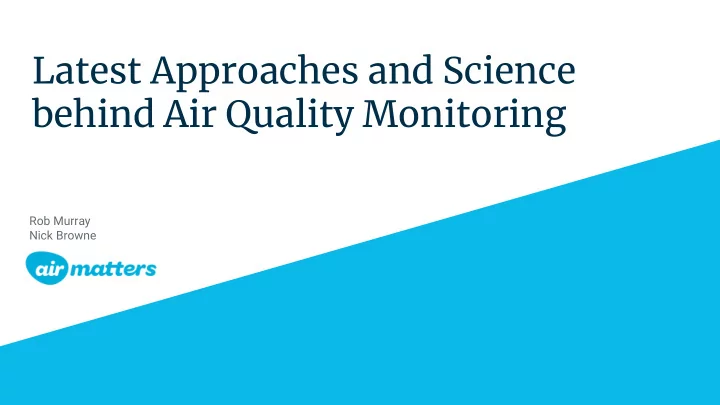

Latest Approaches and Science behind Air Quality Monitoring Rob Murray Nick Browne
Air Quality Joint presentation by Nick Browne and Rob Murray. Both working in the field Monitoring of occupational hygiene and environmental science. Key steps required for monitoring ● New Technology ● What drives the need for ● monitoring ● Issues and challenges
Key Steps Required for Monitoring
Initial assessment Risk profile of job Identification of those affected Material safety data sheet review The point is to control the risk around contaminants. Sampling is just one tool Dose used to understand risk. Length of exposure Real time screening measurements
Accuracy Practicality What will the results tell you about an exposure? Can the monitor work in the situation? Can the results be compared against a regulatory For example: limit? - Intrinsically safe Repeatability - Physical size - Battery life Limits of detection - Data log capability Interferences
Latest Technology
Drones Process Optimisation Emergency Response Radiation AgCon Aerial Group Confined Spaces Large Scale Noise Image courtesy Martin et al, https://www.sciencedirect.com/science/journal/03032434
Drones Re-entry into a site after a serious incident Drone used to enter and measure gas levels before human entry Combination of land and air based drones
Low Cost Sensors Measure range of contaminants - PM 2.5 , PM 10 , NO 2 , VOC Real-time data with mobile apps Designed for citizen science but may soon be available to workplace Flow Egg environments
Video Exposure Monitoring Not a new concept Synchronises real-time concentrations with video images of worker activities or workplace processes Real-time monitoring of dust, organic compounds, noise, temperature Assess peak exposures and identify sources Image courtesy of Dr Jim McGlothlin Compare the effectiveness of controls Communication of results with affected parties
Video Exposure Monitoring Videos from HSE
Video Exposure Monitoring Video from HSE
Mobile Phone Apps NIOSH SLM App Uses built in microphone or external microphone to measure A, C or Z weighted decibels. Based around occupational noise measurements; 1. Run time 2. A-weighted Sound Level (LAeq) 3. C-weighted Peak Sound Pressure Level (LCpeak) 4. Time Weighted Average (TWA) 5. Dose
Tracking and Logging Capabilities Real-time analysers Assign instrument to a user by scanning a tag Assign locations to an instrument by using beacons located around the worksite Assign alarms to areas with restricted entry Connectivity - wireless realtime data sent to central PC Video from Industrial Scientific
Portable Labs Portable GCMS Light, battery powered, on site sampling and analysis (results in 4 minutes) No transport to lab or delay with results Forensics, terrorism, environmental; Organic, pesticides, chemical warfare agents Video from FLIR
What drives the need for improvements in monitoring?
Compliance with regulation New contaminant limits: Respirable crystalline silica - was 0.2 mg/m 3 and now 0.1 mg/m 3 (from 2016 onwards) and potentially lower. Diesel - was not present in WES and now 0.1 mg/m 3 (from 2016 onwards) Others? Nanoparticles - not in NZ WES but within international regulation guidelines and limits are being included.
How small is a nanoparticle? Source: http://www.centerfornanomedicine.org (taken from YouTube)
Engineered Nanoparticles British Standards Institution (BSI) - benchmark guidelines Insoluble nanoparticles = ● ○ 0.066 x OEL of relative microsized material (based off titanium dioxide) Fibrous nanoparticles = ● ○ 0.01 fibres/mL (based on current asbestos clearance level) Highly soluble nanoparticles = ● 0.5 x OEL of relative microsized material ○ CMAR nanoparticles = ● 0.1 x OEL of relative microsized material ○ Source: Risk Bites Youtube channel (supported by University of Michigan)
Sampling Engineered Nanoparticles Traditional sampling not necessarily Three factors in the sampling device: the best for nanoparticles. Number concentration ● ● Difficult measuring particles less Mass concentration ● than 1 micron. ● Surface concentration ● Mass not the only factor of importance
Sampling Engineered Nanoparticles Need to measure down to the ultrafine fraction (yet to be defined) Functional unit for transport and use in a industrial setting for NANODEVICE is a european funded personal and static sampling. project with the following purpose: Separate out background nanoparticles (naturally/normally The idea of NANODEVICE is to occurring from engineered) develop Novel Concepts, Methods, and Technologies for the Production of Portable, Easy-to-Use Devices for the Measurement and Analysis of Airborne Engineered Nanoparticles in Workplace Air. Source: TSI Incorporated (www.tsi.com)
Current sampling techniques for nanoparticles Cascade impactor - mass of different Nanoparticle surface aerosol monitor aerodynamic diameter - surface area of measured particles Overall Condensation particle counter - particle counts
Efficiency Ease of use Comfort of user Increased accuracy versus traditional methods A basic but everyday type of example that Air Matters experiences each day is the improvements in something as simple as a sampling pump. Source: Sensidyne, LP (www.sensidyne.com)
Source: www.sensidyne.com - GilAir Plus Personal air sampling pump
Issues & Challenges
Verification of Sensors The quality of the devices: Air Quality Sensor Performance Evaluation Centre (EPA a part of group to assess technology) Image: TOZA wearable air quality tracker Image: Ecotech - Met One
Compliance with Standards NIOSH SLM app non compliant with National Standards ‘No smartphone or smartphone based-app has met the acoustical and electrical tests required by national or international standards’
Interpretation of Data Large amounts of data to is generated and needs to be analysed. Real-time data misinterpreted by users, esp when compared with public health standards based on longer term exposure. E.G. a low cost sensor measuring dust will be realtime and the WES is a time weighted average. EPA Air Sensor Citizen Science Toolbox
Other Issues Portable GCMS very expensive Intrinsically safe Battery life Image: EBAY Synchronisation for VEM
Summary Smaller New contaminants to consider ● ● More widely available Developments in equipment to ● ● ● More data accurately measure ● And quite exciting? ● Technological improvements being incorporated
Thanks! Auckland and Mount Maunganui nick@airmatters.co.nz rob@airmatters.co.nz www.airmatters.co.nz
Recommend
More recommend